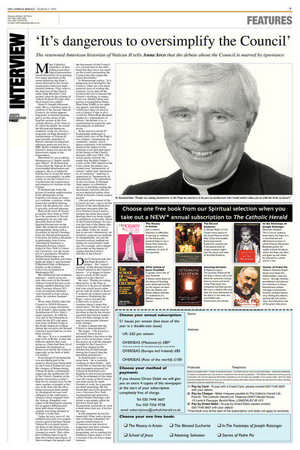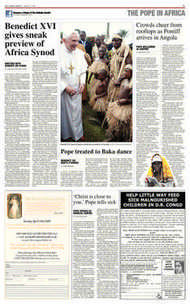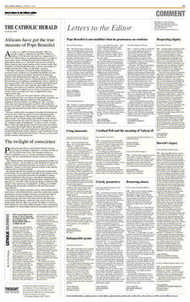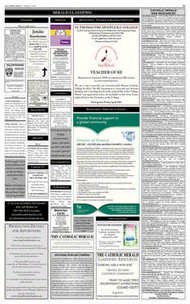Page 7, 27th March 2009
Page 7

Report an error
Noticed an error on this page?If you've noticed an error in this article please click here to report it.
Tags
Share
Related articles
How Vatican Ii Became The Biggest Meeting In The History...
What Vatican Ii Adds Up To
The Vatican Chief Who Will Lie For No One
A Magna Carta Of The Holy Spirit
Modifying Views
‘It’s dangerous to oversimplify the Council’
The renowned American historian of Vatican II tells Anna Arco that the debate about the Council is marred by ignorance Many Catholics, regardless of their political and theological persuasions, found themselves re-examining two major questions in the storm following the Pope’s recent decision to lift excommunications from four traditionalist bishops. First, what is the direction of the Church under Pope Benedict? And second, what do the reforms of Vatican II mean 50 years after the Council was called?
Enter Fr Joseph A Komonchak. His is a familiar name to students of the Second Vatican Council; his byline appears frequently in learned journals and is on the spines of the English version of the fivevolume History of the Vatican II, which he edited. An article the 69-year-old American academic wrote for America magazine on Pope Benedict’s interpretation of Vatican II, later partially reprinted in Britain, became an important reference point not just for a BBC Radio 4 debate about the Church’s future but also for the discussions raging in the blogosphere.
Described by one academic theologian as a “highly intelligent liberal”, Fr Komonchak writes about the Vatican II with even-handed detachment and elegance. He is so balanced that he tries to avoid the temptation to oversimplify; in other words, to see the Council as a war between the conservative and progressive factions in the Church.
Fr Komonchak looks the picture of erudite sophistication in his photograph on the Catholic University of America’s website, a smiling, whitehaired but youthful-looking priest. On the phone his voice is gravelly, rich and pleasant.
Born in the town of Nyack, in upstate New York in 1939, he is the grandson of Slovak immigrants on one side and descends from an IrishEnglish-Puritan mix on the other. His academic record is distinguished: along with a Licentiate in Sacred Theology from the Pontifical Gregorian University he holds a doctorate in philosophy from Union Theological Seminary, a Protestant divinity school linked to New York’s Columbia University, was the recipient of a prestigious Woodrow Wilson Fellowship at the Smithsonian Institute and today holds the John C and Gertrude P Hubbard Chair of Religious Studies at the Catholic University of America in Washington DC.
His intellectual and academic interests – which cover not only the events of the Second Vatican Council but also ecclesiology, modern theology and John Courtney Murray SJ’s work on religious freedom – were fostered in high school, where his teachers inspired him.
When John XXIII called the Council in 1959 Fr Komonchak was a young seminarian in St Joseph’s, Dunwoodie, the Archdiocese of New York’s major seminary. In 1960 he was sent to the Gregorian to study for the STL and spent four years in Rome living at the North American College during the run-up to the Second Vatican Council and for its first three sessions.
He says: “It was a wonderful time to be in Rome, to hear the different debates that were going on. There had been lot of academic development in Rome even before the Council, especially in the field of biblical studies.” Even though Fr Komonchak was not taking part in the massive discussions being held by the Council Fathers he says the vibrancy of Rome during Vatican II made a tremendous impact on the intellectual life of the Church. Students at the Roman universities couldn’t help but be carried away by the sheer number of people in the city at the time and the ideas being discussed, both openly by theological advisers and obliquely in the coded press releases which emerged from the Vatican. Pamphlet wars raged, with theologians arguing for or against different positions held about whatever schema was being debated in St Peter’s at the time.
Today, he says, most of his students have only ever experienced a post-Conciliar Church. Vatican II is as much history for them as the Nicene Council, the face of the Church has changed so much. They often have nothing more to go by than the Council documents. Is there a danger that people read the documents of the Council in a vacuum but on the other hand that they focus too much on the events surrounding the Council that they forget the actual documents?
Fr Komonchak replies: “It is dangerous to oversimplify the Council. There are a far more nuanced ways of reading the Council. To say that all the Council did was to reassert the Church’s teaching, to repeat what was already being said, greatly oversimplifies things. Pope John XXIII, in his opening speech, said that there would have been no need to call a Council if that is all it would do. When Pope Benedict speaks of a ‘hermeneutic of reform’, he defines it as ‘a combination of continuity and discontinuity at different levels’. ” In his America article Fr Komonchak challenges a widely held view of the Pope’s now famous ‘hermeneutic of continuity’ speech, which places continuity with tradition ahead of the impact of the dramatic event that took place in the history of the Church between 1962 and 1965. The article gently reminds the reader that the Holy Father’s words in the 2005 speech to the Curia where the phrase was coined were “hermeneutic of reform” rather than “hermeneutic of continuity” standing in opposition to “hermeneutic of discontinuity”. The opposition of the two terms, Fr Komonchak argues, is a rhetorical device, to facilitate reading the documents correctly and sets up two rhetorical points from which to discern a more nuance picture.
The real achievement of the Council, he says, was to rid the Church of the anti-Modernist reactions prevalent after the First Vatican Council and reanimate the fairly desiccated theology that was being taught in seminaries at the time. Much of the Council though, he says, was the fruit of the labour that had begun decades before it was called. Today he would like to see new commentary on Scripture using newer methods of interpretation, not just the historico-critical method but taking on a structuralist reading, for example, and a deeper discussion on the degree of change that the Council effected in the Church.
Does Fr Komonchak feel that Pope Benedict’s project – the “correct reading” of the Second Vatican Council placed in the Church’s history – is in danger of faltering as a result of the recent upheaval in the Church?
He says: “People are asking themselves: Is the Pope in control or is he just an intellectual who would much rather get on with his book on Jesus? I’ve heard all of those sorts of comments. Explaining the Pope’ s move towards the Lefebvrists in terms of numbers doesn’t make that much sense. The best way of trying to understand what he has done is that he has always regretted that Church leaders have not done enough in the past to stop nascent schisms early enough.” Is there a danger that the Church is more polarised?
He laughs. “The Church is not much more or less polarised than it has been in the past. A new generation, which has grown up with the changes wrought by the Council, is much less shaped by the debates that divided people during the Council than the preceding generations.” Fr Komonchak is due to retire soon – he is currently working on three books – and would like to translate the original documents prepared for Vatican II from Latin into English so that textual histories of the development of the ideas over the course of the Council can more easily be made. Outside of work, he is passionate about genealogy. He has found that one of his ancestors was a Victorian New York businessman and spiritualist called Charles Partridge, who edited a newspaper called the Spiritual Telegraph. Fr Komonchak would like to write a book about him too, if he has the time.
In the meantime he has his hands full. What with a lecture tour of Europe scheduled, his regular contributions to Commonweal and America magazines and their websites and his normal teaching programme, not to mention his ambitious future plans, it’ll be a miracle if he can find a spare moment.
blog comments powered by Disqus





















